It has been lurking insidiously in the background for some time now. In 2017 there were plans to kill the presidential candidate for the radical-left La France Insoumise, Jean-Luc Mélenchon, and the mayor of Forcalquier in south-east France, the future interior minister Christophe Castener. In 2018 there was a plan to poison halal food, and another to attack the French president himself, Emmanuel Macron. In 2019 Muslim and Jewish places of worship were set to be attacked. And in 2020 the Jewish community was once again a target. On each occasion the plans were foiled before they could be carried out.
But despite that, similar appalling plots have continued to be hatched right up to the present day. In early May 2021 members of a neo-Nazi group aiming to attack a masonic lodge were arrested. That brought to six the number of planned attacks attributed to the ultra-right that have been foiled in the last four years. There is also an attack which has not been labelled as terrorist, but which strongly resembles one; at the end of 2019 a racist in his 80s, Claude Sinké, tried to set fire to a mosque at Bayonne in south-west France before opening fire on two worshippers, seriously injuring them.
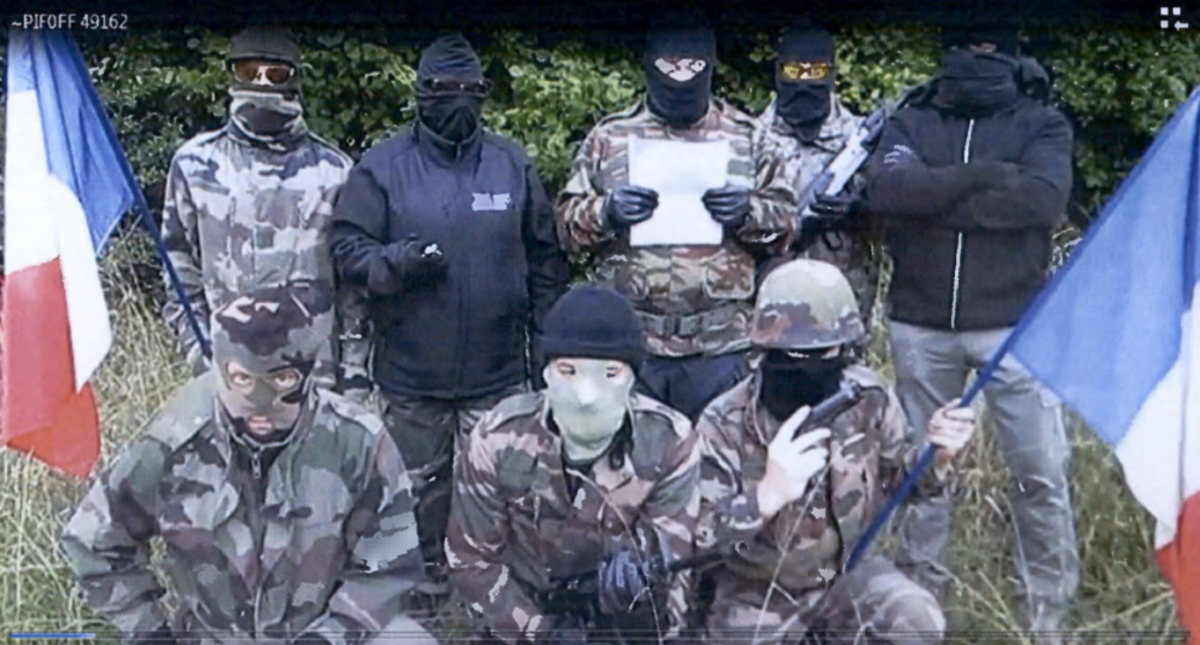
Enlargement : Illustration 1

Ultra-right violence is back. It is true that the level of intensity is not as high as that of jihadist terrorism, which has killed 264 people in six years. From 1986 to the current day the actions of groups calling themselves ultra-right have caused the death of 17 people, according to analysis carried out from 2016 to 2019 by the University of Lorraine in north-east France as part of the Vioramil research project into radicalisation.
Intervention by the security forces have avoided the kinds of massacres carried out by jihadists. But the presence of a hard core of around a thousand ultra-right activists – according to an assessment by France's domestic intelligence agency the DGSI in 2020 – with perhaps another 2,000 followers on top of that is nonetheless cause for concern, particularly given the growing number of planned attacks.
That, at any rate, is the assessment of the public authorities at both national and European level, as Mediapart has already reported. “We have passed a threshold,” said Naïma Rudloff, advocate general and head of the prosecution service charged with tackling terrorism at the court of appeal in Paris, in an interview published in the Catholic newspaper La Croix on Friday May 21st. “For a long time on the ultra-right we saw individuals making hateful comments – racist or anti-Semitic – now we have to deal with advanced plans of attack...”

Enlargement : Illustration 2

Today Mediapart reveals further proof of that growing threat in the form of a 56-page document written by the prosecution authorities at the court of appeal in Paris where Naïma Rudloff is based. Dated March 2021, this eleventh edition of the confidential 'Bulletin sur le terrorisme' produced by the prosecution authority that oversees France's anti-terrorism prosecution unit, the Parquet National Antiterroriste (PNAT), is devoted to the threat posed by the ultra-right in France.
Its unnamed author or authors note that “since 2016 some activists from the ultra-right have striven through their actions to cause major damage to public order, through intimidation and terror”. To support these comments, the authors look at the seven current investigations into terrorist conspiracies blamed on the ultra-right, and which are being handled by the PNAT. The attack on the masons was not known about when the report was written. Mediapart, meanwhile, has cross-referenced the prosecutors' conclusions with witness statements drawn from those cases, from secret DGSI reports, from studies published by academics and from the result of Mediapart's own previous investigations.
An obsession with interracial civil war
The prosecution service notes in the report that in all the current criminal investigations the “activists' vision of the world is shaped by an obsession with interracial civil war”. However, not all the ultra-right militants see this war in the same way; some of those under investigation think that this civil war is imminent. The rest believe it has already begun, triggered by the jihadist terror attacks in France that began in 2015.
In its literature and public comments the group Action des Forces Opérationnelles (AFO), which was dismantled in June 2018, makes no reference to Nazism or fascism. However, its members are obsessed by the 'Great Replacement', the conspiracy theory which claims that the elites in power want to substitute European populations with people from Africa and the East. As a reprisal for the next major jihadist attack the AFO was planning to target “radical” imams, to throw explosives in a mosque and also to attack women wearing veils. Their plans even went so far as proposing to poison shelves of halal food in supermarkets in the Paris region.
The Paris prosecutors consider that for these ultra-right groups “deeply imbued with numerous conspiracy theories … Islam and Muslims have become the most useful scapegoats”. The reports says that this can be seen in all the ongoing investigations. One person under investigation wrote on their Facebook page: “Arabs, Blacks, local rabble, migrants, dealers, jihadists: you, too, dream of killing them all. We've made it a pledge. Join us.” In 2019 Mediapart revealed details about the website Réseau Libre, several members of which had sought to carry out attacks aimed at the Muslim community.
While Muslims remain the preferred target for the ultra-right activists under investigation, the prosecution service notes in the report that there remains an “anti-Semitic obsession”. In one of the investigations, the online identity of one activist contains the words “I hate Jews” though it is written in a deliberately vague way as “ayatjiouz”.
The report sets out a long list of the disparate “negative emotions” which are expressed by those being investigated in the current cases: “A hatred of immigrants, of migrants, of Jews, of homosexuals, of the [French] Republic; speech that is profoundly Islamophobic, anti-feminist and misogynist”.
The expression “traitor” can also be added to the list as a term that, according to the prosecutors, is used to “unite the community around a militant counter-model and reinforce a bipolar and antagonistic vision of politics”. In one case that goes back to 2017 “white people who smoked joints or adopted an 'African style'” were singled out as deserving punishment.
Ideological references from polemicist Éric Zemmour to survivalism
Another motive that drives members of the ultra-right to action is a desire to re-write history, to put forward an alternative version to the one “written by the victors”, and to defend the memory of the vanquished. In the neo-Nazi groups facing prosecution for “terrorist conspiracy” the pseudonyms used by the members unsurprisingly relate to the beliefs of the Third Reich. In some cases there are also references to the Algerian War. According to the ultra-right, the recent terrorist attacks by jihadists are simply a continuation of that bitter conflict.
One example is the sticker found at the home of one of those arrested which proclaims: “OAS – French rebel crew since 1961”. This is a reference to the Organisation Armée Secrète paramilitary group which opposed Algerian independence from French rule. The prosecutors point out that these references to the Algerian War were inspired by the declarations of the “polemicist Éric Zemmour” who in the autumn of 2016 had claimed on the LCI television news channel: “This is about revenge for the Algerian War!” The prosecutors' report states that these comments were “widely echoed inside the obscure world” of the ultra-right. In the AFO case one of those under investigation, a man in his forties, cited books by Éric Zemmour among his reading alongside Catholic religious works.
As well as Zemmour, activists on the ultra-right involved in the current cases and who are interested in violent action universally make reference to the racist White survivalist movement which predicts inevitable and imminent energy, environmental, political and social collapse. In one 2018 case in France a man who was later put under investigation offered training in combat, rescue work, topography, airsoft – similar in concept to paintball – and lessons in survivalism to “resist Islam”.
In the AFO case many of those under investigation say they have organised or taken part in “survivalist courses” to prepare for a “civil war” they say is imminent. One of them said that he practised this alone in the forest and that he liked to be able to “push myself to the limits of survival and to reflect”. Another, who took part in two courses at Chablis in central France, was described by her daughter in the following way to police officers: “My mother had become strange. She went shooting and did courses in survivalism. She said she wanted to hunt. She had a survivalist outlook. She said that our land was polluted and that soon there'd be nothing more to eat. She has an apocalyptic view of the world. She thinks that civil war is imminent.” A third person under investigation said they enjoyed playing survivalist video games. During the AFO probe detectives also found lists of survival equipment and evacuation plans.
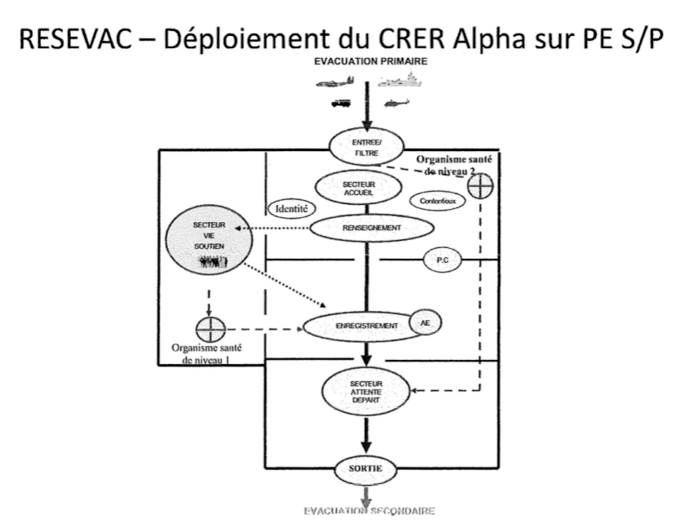
Enlargement : Illustration 3

The final point of reference for those involved in ultra-right violence is the most chilling of all: the 'glorious' predecessors who have carried out mass murder in the last 30 years in the name of a far-right ideology.
The Paris prosecution report highlights the “form of fascination” that the people who carry out these mass killings inspire in the activists currently under investigation for terrorist conspiracies, and “particularly among the youngest”. In April 2020 a young activist published photographs of Timothy McVeigh on social media; McVeigh carried out the Oklahoma City bombing in 1995 that killed 168 people and injured more than 680. The photos of McVeigh were accompanied by the hashtag '#Saint'.
The young French militant's post also contained a photo-montage representing the “saints” Anders Breivik, Timothy McVeigh, Brenton Tarrant, Dylann Roof, Robert Bowers and John T. Earnest, all perpetrators of mass attacks of a racist and anti-Semitic nature.
Norwegian Anders Breivik killed 77 people on July 22nd 2011, first of all by exploding a bomb in Oslo, then opening fire at a Workers Youth League summer camp on the little island of Utoya. His name keeps cropping up in French antiterrorism cases. In 2017 a resident of Argenteuil in the Paris suburbs was arrested because he was planning to attack “Muslims, Jews, Blacks, homosexuals”. He was later convicted and given a seven-year jail term for this. Just a year earlier the same young man, aged 25 at the time, had been given a three-year prison sentence, 18 months of which were suspended, for inciting racial hatred and condoning terrorism. That came after he poured out his unhealthy fascination for Breivik on social media.
Also in 2017 Logan Nisin, who founded a group called Organisation des Armées Sociales (OAS) – a direct and deliberate reference to the OAS from Algerian War days - was arrested at Vitrolles in south-east France over plans to murder Jean-Luc Mélenchon and Christophe Castaner. Among his activities Nisin managed a Facebook page in honour of Anders Breivik. In 2016, meanwhile, another group on the extreme right described the Norwegian as a “worthy nationalist”.

Enlargement : Illustration 4
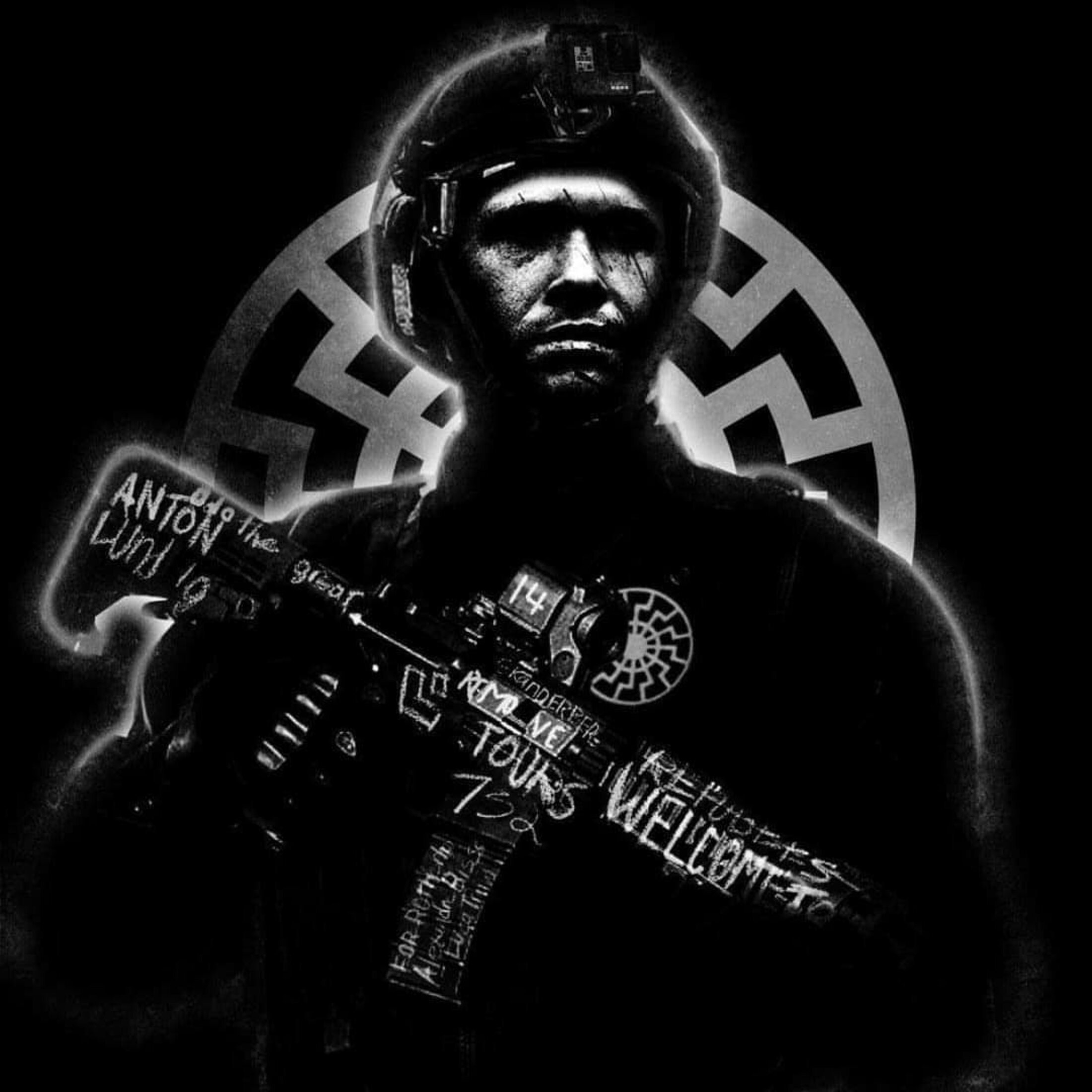
Whatever their individual motivation, all those seeking to take part in violent action have the same basic view: that the French state has failed in its mission to protect them from the jihadist terrorist threat. As a result they feel the need to take the place of the state (in two of the seven terrorist cases being investigated there was talk of the army seizing power) and, if necessary, eliminate its representatives. As has been seen, the opposition politician Jean-Luc Mélenchon and the future interior minister Christophe Castaner were the targets of murder plots. But it is the president who is the main focus of hatred and who has been the target of several plots, some more advanced that others.
The resident of Argenteuil mentioned above acknowledged that he wanted to “shoot” Emmanuel Macron on “July 14th [editor's note, Bastille Day] or during a visit”. He explained: “If you have to go down, it might as well be for killing a politician and destabilising the system.”
In 2018 Les Barjols became the dominant group in the ultra-right movement. Some of its members trained in using weapons and encrypting communications during workshops on farmland in the Meuse département or county east of Paris. During one of these meetings in 2018 around fifteen members of Les Barjols met and discussed in small groups of two or three the best ways to “attack migrants and the president of the Republic”. According to one participant at what was – initially - supposed to be a survival course, their plan was to “get as close as possible to the president of the Republic when he was in a crowd and kill him … that's all that was spoken about, all evening, that's all they spoke about.”
But the plan went nowhere, to the point where one senior member of Les Barjols left the group to go off and take action along with a few determined accomplices. This man, a 63-year-old from the Isère département in the French Alps, was arrested in November 2018 as he was trying to find a ceramic knife which is undetectable by standard security detectors. This activist, who on his Facebook account described the head of state as an “hysterical little dictator” and a “little clown”, was at the time arriving by car in the Moselle département in north-east France with an accomplice. At the same time the president was preparing to visit the area to commemorate the centenary of the Armistice marking the end of World War I.

Enlargement : Illustration 5

In its report the prosecution service at the court of appeal notes: “The figure of President Macron has, since his election, aroused major hatred. That has been fed by conspiracy theories, tinged with anti-Semitism – Emmanuel Macron is seen as 'Rothschild's man'”. This is a reference to the fact that Macron used to work at Rothschild & Co in France as an investment banker. He is depicted as the “nation's assassin” who will lead it to being “submerged by abroad”. Members of Les Barjols thus took to social media to “demand” the president's resignation “otherwise actions will be taken against this illegitimate government and against all the things IMPORTED BY IT!”.
Apart from the head of state, there is a range of institutional targets. Indeed, the list goes further than that: anyone who, in the minds of the conspiracy theorists, represents authority of power could be justifiably eliminated.
A masonic lodge was the target in the latest attack plot foiled by the security forces. It was the plan of the neo-Nazi “Honneur et Nation”, a group which the prosecution report says is openly anti-Semitic. It quotes their propaganda: “France should no longer be called the Republic, because the Republic is Jewish, and France is French. This hydra must be eliminated, it's a shame because one person tried to do it, and he turned everyone against him, Adolf HITLER.”
According to a secret DGSI report, two men within Les Barjols, including the one who later planned to attack the president, had expressed a desire in 2018 to murder freemasons in one of the mess halls frequented by lodge members in Paris.
Well-integrated members of society
Hatred of others, anti-Semitism, fear: these motives noted among the ultra-right activists under investigation are the traditional hallmarks of the movement. But their profiles are much less so. In its report the prosecution service at the court of appeal in Paris points out that an analysis of the current cases does not enable them to identify a “typical profile of an ultra-right activist likely to attempt armed action”. In fact, in at least four cases there is a wide range of age groups, with the men and women involved aged between 20 and 60 years old. “Their well-integrated social profiles is at sharp contrast with an image of the ultra-right being made up of post-adolescents living on the margins of society,” write the prosecutors.
In his report published at the start of this year, the historian specialising in the far right, Nicolas Lebourg, draws a distinction between different groups: for example, the members of Logan Nisin's OAS came from working class backgrounds, whereas those in the AFO were more likely to come from the middle classes.
The members of Les Barjols, who were arrested in 2018, also come from quite tough backgrounds. Having been an assembly-line worker, then a builder, then a fishmonger, one of the members of the plot to assassinate Emmanuel Macron lives on social benefits. In between railing against the government and big business, he became interested in the figure of Guy Fawkes, whom he discovered in the film V for Vendetta.
The activist who dreamed of killing the French president, a former mechanic, suffers from cancer of the intestines, has a daughter with a motor disability, lost another daughter to a brain tumour when she was aged 7, and has fallen out with his third daughter. She felt obliged to block him on Facebook after the last presidential election in 2017 as she was so embarrassed by his political comments.

Enlargement : Illustration 6

These backgrounds are far removed from those of some of the AFO members, who include a former French diplomat, a former engineer and a senior maths teacher, a former director of human resources in a branch of the Thomson electronics group in France, an IT consultant, a decorated former soldier, a company boss, a restaurateur, an accountant, a self-employed plumber, an employee at the French post office La Poste and at France Télécom, a telesales rep, a secretary in a bank branch and a psychiatric nurse.
The leader of the Paris region section of the AFO, who called himself 'Cortés', was none other than the number two at the French embassy in El Salvador in Central America, where his net take home pay was 11,000 euros a month – he had a previous career in the navy and military intelligence. A woman in her fifties, who worked with an association which supports members of the gendarmerie, declared annual taxable income of 40,000 euros.
Some of the activists vote for Marine Le Pen's Rassemblement National (previously the Front National) which one described as the “least bad” option, or have stopped supporting the parties of the centre right – the RPR, then the UMP which is now Les Républicains (LR) – in favour of small right-wing nationalist groups. But others speak of a continuing commitment to the Right. One of those placed under investigation said they were “close to the LR but not to the far right”. Another stated: “I was on the Right. I voted for [Nicolas] Sarkozy. I've never voted for Le Pen.” Yet another defined himself as a “Gaullist patriot but not excessively capitalist” and said they had voted “for the Right” and “did not have confidence in the extremes and in particular Rassemblement National and [editor's note, the radical-left] La France Insoumise”.
For several of them the trigger event for their radicalisation was the terrorist attacks that struck France in 2015 and 2016. An AFO member in his forties became a traditionalist Catholic and acknowledged his “political and social marginalisation”. He told detectives: “I sought a path that could ease my fears and anxieties.” A woman in her fifties signed up at a rifle range before joining an ultra-right group because she was “a little bit afraid and needed to find people who thought like me, a mutual support group.” A female nurse living in the Seine-Saint-Denis département on the northern outskirts of Paris, who threw herself into survivalism, explained: “Before coming to the capital I lived in a village. I regret the fact that every ten metres there are Arabs who piss me off … After [President François] Hollande it got worse. I can no longer bear what's said about Whites … After the [2015] attacks I was afraid. Afraid for me, my children, my country.”
A senior maths teacher in his sixties, who taught in an education priority zone for 18 years, explained that he joined the AFO because of the reaction of his Muslim pupils after the terrorist attack on the satirical weekly Charlie Hebdo in January 2015. “Ninety-five percent of my class were Muslims and they completely supported the terrorist act. I can remember not being able to give a lesson the following day because they just kept on showing me photos of the cartoons of Mohammed,” he said, referring to the caricatures in the magazine that were used to justify the attack. He was called in by the school's head teacher after sending him a racist letter.
To find a label for these atypical activists – people who came from the middle classes or above, who converted to Catholicism after the terrorist attacks of November 13th 2015, who are integrated into society, good at using social media and keen to carry out violent action – the DGSI created a new category at the end of 2019 among their ultra-right profile types. They were called the “neo-populists” or “neo-patriots”.
However, there is one common thread between all the groups, and one which has often been highlighted by Mediapart: and that is the presence in them of members of the security services. According to the prosecutors' analysis in their report, out of the seven cases currently under investigation, five involve current or former military personnel. One of those arrested as part of a group, a volunteer auxiliary gendarme, had had problems with their superiors because their brigade commander was a Muslim. He was later excluded from the gendarmerie, which is part of the armed forces in France.
In the spring of 2018 Mediapart revealed the DGSI's concerns over the issue. They had alerted the public authorities about the growing proportion of military personnel or members of the security forces who had joined ultra-right groups. At the time the intelligence services had “around fifty police officers, gendarmes and military personnel” among their “targets” who were being monitored because of their links with “the violent extreme right”. That is around double the number of police or military personnel being monitored because of their involvement in radical Islam, to go by the declarations of the Ministry of the Interior. The day after four police employees were stabbed to death at Paris police headquarters in October 2019, the ministry said there were around twenty police officers and around a dozen gendarmes who were being monitored over suspicions that they had converted to Islamic fundamentalism.
Mediapart has already reported on the ultra-right 'Rémora networks' set up by a former senior intelligence officer. The head of the AFO, who was known as 'Richelieu', was himself a retired police sergeant. Another member was a former soldier who had served 178 days in Afghanistan and who wanted to “defend and protect himself in case of chaos … if France went up in flames like Syria”.
Even when they are not actual members of the security forces, activists in the most violent ultra-right groups often have connections with the military and security world. Inside Logan Nisin's OAS there was the son of a gendarme and the son of a police officer as well as a pupil at a flying school for non-commissioned officers.
In the AFO case, several of those under investigation have former military personnel or police officers in their close family. Target shooting enthusiasts in the group used this sport to try and recruit soldiers from two parachute regiments based in the south-west of France. As historian Nicolas Lebourg has pointed out, during a search of one of the members of this group detectives found an “outline for recruitment interviews”, a questionnaire asking about the potential member's activist background, their motivation, their expectations, their abilities, and also the “material resources that they have in case of a crisis” and if they are capable of putting a “bullet in the head” of someone if their country or their values are seriously threatened.
The professionalism of the ultra-right cells
At the end of 2017 the DGSI described how the ultra-right was “splitting up” into small groups, which it said highlighted the “amateurism of the ultra-right scene” and the “movement's poor operational capacity”. But two years later the domestic intelligence agency regretted the fact that its “clients” now had access to encrypted communication methods and “put in place counter-surveillance measures” when they met accomplices. The security agencies began to grasp the increasing professionalism of the ultra-right cells in June 2018 when the AFO was dismantled.
During searches detectives got hold of the secret organisation's organisational structure. It had some 110 members split into ten regional sections covering around sixty départements. It was an extremely hierarchical system, very partitioned, with a colour code relating to a person's status and abilities. Four levels of clearance determined access to internal information. On top of the national network AFO also had a group called 'Action' which tried to recruit members of the military and security forces.
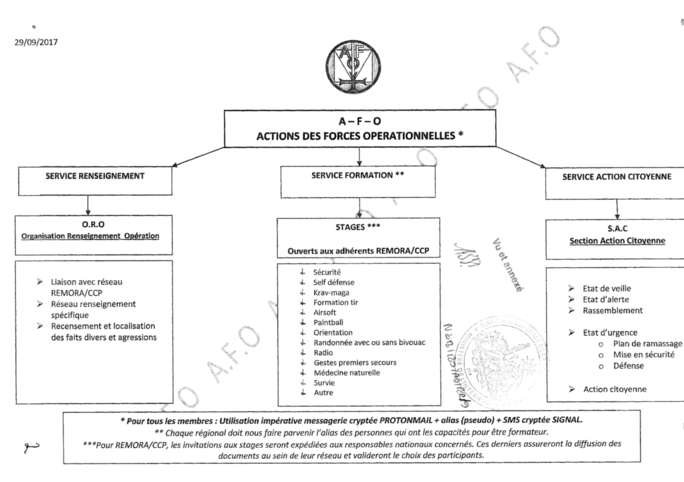
Enlargement : Illustration 7

In its report the prosecutors note that in all the groups facing proceedings over terrorist conspiracy, the youngest members were “initiated in methods of action during physical training sessions and in learning military rules and methods”. In the spring of 2018 the Paris region section of AFO, which had around ten members, went further in training members how to handle explosives. It was this that led to the judicial investigation being stepped up and the arrest of the suspects, amid concern that they were about to take action.
The operations envisaged by the terrorists ranged from poisoning halal food in supermarkets to blowing up worshippers during prayers in the streets, bookshops that stocked hard-line Islamist literature or simply motorists. The AFO used the internet to search sites in the United States to find out how to poison halal meat, seeking a poison that was capable of causing haemorrhages in healthy people and death in weaker people. When questioned by an investigating judge one of those under investigation said: “[A leader] expressly asked me to work on this plan.” According to the academic Nicolas Lebourg, one meeting of the OAS discussed the merits of using a flame-thrower in a crowd.
Groups that have no problem arming themselves
Unsurprisingly, activists in ultra-right groups show a fascination for weapons. A significant number of them take part in target shooting or go hunting. Mediapart understands that in 2019 the intelligence services estimated there were 350 members of such groups who legally owned one or several firearms. Out of these, 147 were the subject of a file held by the security services.
In their report prosecutors note that “unlike with recent jihadist cases none of the ultra-right cases under investigation show any potential difficulties in getting hold of weapons for those involved”. This view is shared at European level. A confidential report by Europol in 2019 showed that far-right groups were involved in buying weapons and making explosives.
Mediapart has seen the evidence given in a closed session by senior official Bruno Dalles to a French Parliamentary committee of inquiry into the fight against ultra-right groups in France. Dalles, who was at the time the director of Tracfin, the French Treasury body that tracks suspicious payments and money laundering, detailed the supply system used by ultra-right activists, which went via one company in particular “where the process of compulsory liquidation lasted abnormally long”. This liquidation began in 2015 and was still in progress in 2018. That allowed the group to use it as cover for buying assault rifles, Bruno Dalles said. “We identified some trips by managers at this company to Belarus, more exactly to a town close to the Ukrainian border known by the intelligence services as a place to buy and trade weapons,” he told committee members.
Members of Logan Nisin's OAS bought their weapons via an association set up to develop eco-villages. Mediapart understands that the DGSI was also interested in a paramilitary organisation whose founder, a resident in Poland, took advantage of more relaxed weapons laws there.
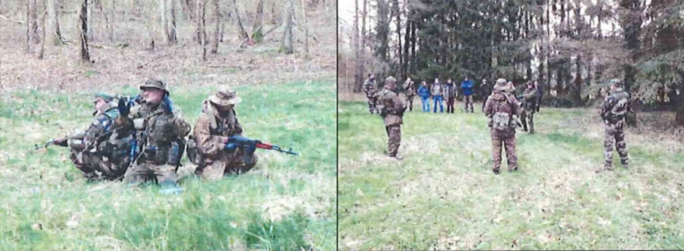
Enlargement : Illustration 8

No detail was overlooked. In one document written by its “legal centre”, the AFO reminded members of the “behaviour to adopt when dealing with the police and legal system”. There are three pages of recommendations on what to do when the police ask for your identity papers, or during a search or when held in custody. On the section on behaviour in police custody, activists are particularly recommended to be “wary of cellmates who are sometimes chatty (informers or even plain-clothed police officers passing themselves off as a criminal)”. The author of the section says: “Walls have ears.” Above all, activists had to adhere to the same mantra at each stage of any judicial proceeding: “Do not pass on details of supporters and organisation contacts.”
Detectives found a “war communiqué” at the home of the leader of one of the groups: it had a list of enemy personnel and planned an operation on the anniversary of the November 13th 2015 attacks in Paris in order to “avenge the victims of the Islamic attacks that have taken place since 2015”.
Some activists seem to have enjoyed the excitement of planning rather than having a real desire to carry out the acts, but others became impatient when the plans took a long time to materialise. One AFO member, for example, wrote: “When are the targets going to be identified at national level? Why haven't they been? Why do we just get evasive replies? The guys have had enough of preparing without knowing for what. I sense huge doubts developing in the best of them. Local, deadly operations to consider? Halal? Mosque? These two points are currently being prepared by us by specific groups. When they're ready, what will they be told? Will they be asked to wait? And to wait for what?”
The retired mechanic who planned to assassinate Emmanuel Macron justified his departure from Les Barjols over weariness at the way they discussed revolution at barbecues but never carried it out. “It wasn't progressing as far as I was concerned,” he said. “Apart from grilling food nothing happened.”
The main risk, and one the authorities fear, is that a lone individual who is fed up with the constant talk and posturing decides to take matters into their own hands and do something. “In practically every case those who have been caught had moved towards a terrorist plan partly because they didn't identify either with Rassemblement National or with a radical group,” conclude the prosecutors in their report.
Once a campaign of attacks starts, there is no turning back. In 2018 some members of Les Barjols visited bunkers on the Maginot Line that were supposed to be a place of refuge “after killing the president”. One member of the plot warned on the Telegram message app: “Once action has started, we'll be treated as terrorists, enemies of the Nation. Life will never be the same as it was before.”
In a very recent case one of those under investigation flaunted his membership of the international group Atomwaffen Division, which was set up in the 2015 and chiefly based in the United States where it promotes the theory of “accelerationism”. This theory, which has become very popular among the ultra-right in recent months, states that violence and terrorism should be used to create chaos in society. This, the argument runs, will finally trigger the long-awaited interracial war.
-------------------------
If you have information of public interest you would like to pass on to Mediapart for investigation you can contact us at this email address: enquete@mediapart.fr. If you wish to send us documents for our scrutiny via our highly secure platform please go to https://www.frenchleaks.fr/ which is presented in both English and French.
-------------------------
- The original French version of this article can be found here.
English version by Michael Streeter


